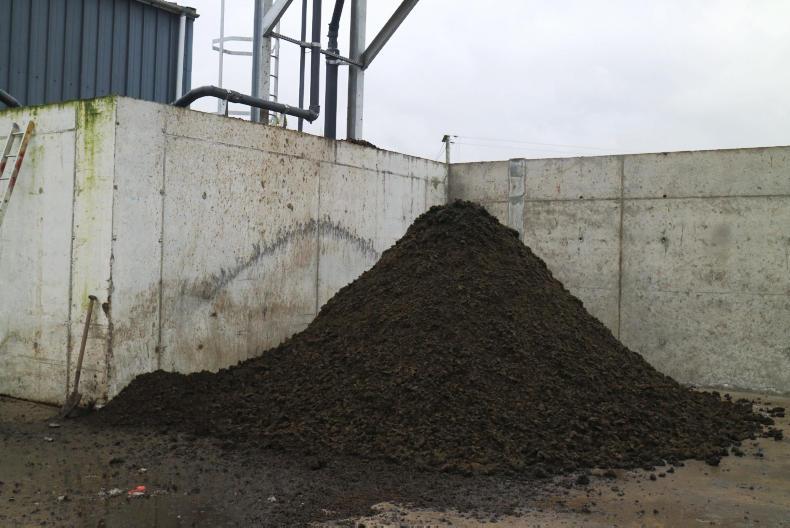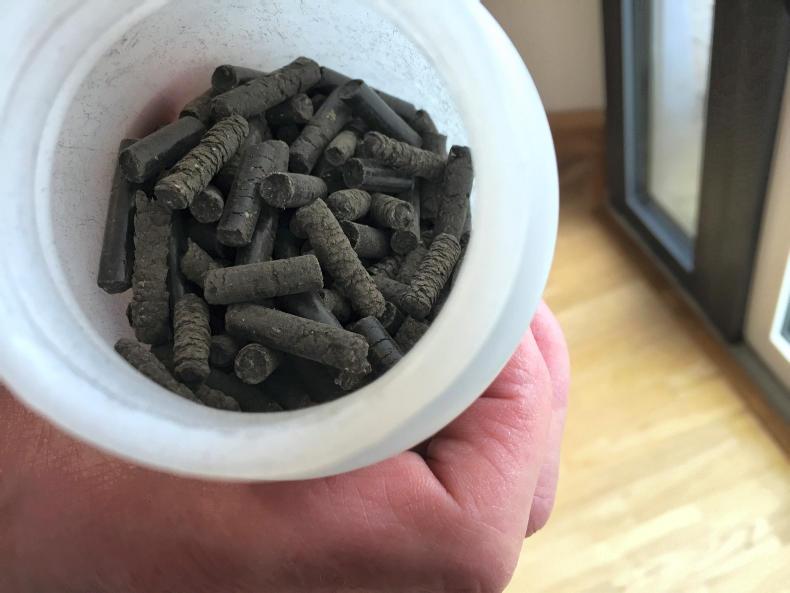Digestate is the material remaining after the anaerobic digestion (AD) of a feedstock. It typically has a low dry matter (4% to 6%) with a high water content, a high pH (>8) and it is about 85% or more of the volume of the feedstock. Its nutrient value generally depends on the feedstock material.
Digestate can be used as fertiliser, reducing costs to farmers while decreasing greenhouse gas emissions and chemical fertiliser applications.
I recently spoke to UK digestate consultant Bryan Lewens who explains that nutrients in digestate, particularly nitrogen, are more freely available for plants to uptake than in untreated organic waste sources. For example, nitrogen availability in digestate could be increased by up to 10%.
In an example, based on nutrient analysis, Bryan estimated that at an application rate of around 30m3/ha, the nutrient value of digestate equated to around €131/ha. This value assumes UK baseline prices for urea (46%) at €345/t, triple superphosphate (46%) at €395 and muriate of potash at €321/t.
While digestate does have an odour, it is generally not as strong as the undigested feedstock material.
The AD process can also reduce microbial pathogens and the germination capacity of weed seeds found in the raw feedstock.

The solid fraction of the digestate can be spread on land.
Challenges
When designing an AD plant, the importance of planning for digestate management cannot be overstated.
Digestate is usually land spread, as it is a great source of nutrients.
But this land spreading must be conducted in line with the Nitrates Directive and crop requirements to ensure there is no pollution of watercourses or damage to the environment.
Having an appropriate plan in place for digestate management including, sufficient storage facilities and access to a landbank large enough for spreading is crucial in the planning process.
AD plant owners are now looking for new technologies to further process digestate, decreasing overall volumes and increasing its nutrient value.
Emerging technology is now making this possible.

Dried digestate can be pelleted and used as fertiliser.
Digestate upgrading
As part of the recent IBBK biogas training course in Enniskillen, course director Michael Köttner outlined some of the emerging upgrading technologies to treat digestate.
This includes liquid-solid separation and complete nutrient separation.
One turnkey digestate treatment technology which is operational on a small number of AD plants in Germany separates water from nutrients using vacuum evaporation, significantly reducing overall digestate volumes.
Using the primary heat from the combined heat and power plant (CHP), the digestate is heated to boiling point under vacuum, through two vessels.
This evaporates the water in the digestate as vapour.
The condensate vapour is treated to remove the ammonia (NH4), creating a pH-balanced concentrate liquid.
This minimises losses of NH4 during spreading and also makes the nitrogen available in the concentrated form of ammonium sulphate solution (ASS).
As a rough guide, for every 1kW of heat input, 2.5l of water are extracted from the system. This means that for every 60m3 of digestate treated, 30m3 of water is extracted per day.
The treatment system reduces digestate liquid volume by up to 70% and also allowed the landbank required for running the digester.
Process
Digestate is first mechanically separated using a screw press separator. The solid fraction can be further dried to be pelleted or spread directly on to land. The separated liquid is introduced into the system under vacuum for evaporation.
The vapour that is produced though this process is stripped of ammonia by adding sulphuric acid.
In this process, ammonia is converted into ammonium sulphate and concentrated.
The ammonium sulphate solution (ASS) can be applied on to crops using a sprayer or sold to industry. The vapour produced in this process, which has been stripped of ammonia, is condensed to form water (distillate).
Once cooled, it passes through a treatment tank and this water can then be used in the operation of the plant or the farm.
Residual gases from process are fed back into the biogas plant and are either metabolised (H2S that is converted into sulphur) or burnt in the CHP (CH4).
This digestate treatment system significantly reduces the digestate storage requirements, by creating a concentrating liquid fertiliser (ASS) and digested liquor.
It reduces the land bank required for digestate, as well as reducing the cost of transportation and spreading.
Where does this system fit?
The digestate vacuum evaporator can be installed as a turnkey solution to existing AD plants that meet all the operational and viability requirements, such as heat and large digestate removal costs.
It can be part of the planning application for future AD plants as a solution to digestate management, potentially increasing the overall viability of a plant.
Read more
ITLUS looks ahead with ‘Visions for the Future’
IFA potato report: 15% to 20% of potato crop left to be harvested
Digestate is the material remaining after the anaerobic digestion (AD) of a feedstock. It typically has a low dry matter (4% to 6%) with a high water content, a high pH (>8) and it is about 85% or more of the volume of the feedstock. Its nutrient value generally depends on the feedstock material.
Digestate can be used as fertiliser, reducing costs to farmers while decreasing greenhouse gas emissions and chemical fertiliser applications.
I recently spoke to UK digestate consultant Bryan Lewens who explains that nutrients in digestate, particularly nitrogen, are more freely available for plants to uptake than in untreated organic waste sources. For example, nitrogen availability in digestate could be increased by up to 10%.
In an example, based on nutrient analysis, Bryan estimated that at an application rate of around 30m3/ha, the nutrient value of digestate equated to around €131/ha. This value assumes UK baseline prices for urea (46%) at €345/t, triple superphosphate (46%) at €395 and muriate of potash at €321/t.
While digestate does have an odour, it is generally not as strong as the undigested feedstock material.
The AD process can also reduce microbial pathogens and the germination capacity of weed seeds found in the raw feedstock.

The solid fraction of the digestate can be spread on land.
Challenges
When designing an AD plant, the importance of planning for digestate management cannot be overstated.
Digestate is usually land spread, as it is a great source of nutrients.
But this land spreading must be conducted in line with the Nitrates Directive and crop requirements to ensure there is no pollution of watercourses or damage to the environment.
Having an appropriate plan in place for digestate management including, sufficient storage facilities and access to a landbank large enough for spreading is crucial in the planning process.
AD plant owners are now looking for new technologies to further process digestate, decreasing overall volumes and increasing its nutrient value.
Emerging technology is now making this possible.

Dried digestate can be pelleted and used as fertiliser.
Digestate upgrading
As part of the recent IBBK biogas training course in Enniskillen, course director Michael Köttner outlined some of the emerging upgrading technologies to treat digestate.
This includes liquid-solid separation and complete nutrient separation.
One turnkey digestate treatment technology which is operational on a small number of AD plants in Germany separates water from nutrients using vacuum evaporation, significantly reducing overall digestate volumes.
Using the primary heat from the combined heat and power plant (CHP), the digestate is heated to boiling point under vacuum, through two vessels.
This evaporates the water in the digestate as vapour.
The condensate vapour is treated to remove the ammonia (NH4), creating a pH-balanced concentrate liquid.
This minimises losses of NH4 during spreading and also makes the nitrogen available in the concentrated form of ammonium sulphate solution (ASS).
As a rough guide, for every 1kW of heat input, 2.5l of water are extracted from the system. This means that for every 60m3 of digestate treated, 30m3 of water is extracted per day.
The treatment system reduces digestate liquid volume by up to 70% and also allowed the landbank required for running the digester.
Process
Digestate is first mechanically separated using a screw press separator. The solid fraction can be further dried to be pelleted or spread directly on to land. The separated liquid is introduced into the system under vacuum for evaporation.
The vapour that is produced though this process is stripped of ammonia by adding sulphuric acid.
In this process, ammonia is converted into ammonium sulphate and concentrated.
The ammonium sulphate solution (ASS) can be applied on to crops using a sprayer or sold to industry. The vapour produced in this process, which has been stripped of ammonia, is condensed to form water (distillate).
Once cooled, it passes through a treatment tank and this water can then be used in the operation of the plant or the farm.
Residual gases from process are fed back into the biogas plant and are either metabolised (H2S that is converted into sulphur) or burnt in the CHP (CH4).
This digestate treatment system significantly reduces the digestate storage requirements, by creating a concentrating liquid fertiliser (ASS) and digested liquor.
It reduces the land bank required for digestate, as well as reducing the cost of transportation and spreading.
Where does this system fit?
The digestate vacuum evaporator can be installed as a turnkey solution to existing AD plants that meet all the operational and viability requirements, such as heat and large digestate removal costs.
It can be part of the planning application for future AD plants as a solution to digestate management, potentially increasing the overall viability of a plant.
Read more
ITLUS looks ahead with ‘Visions for the Future’
IFA potato report: 15% to 20% of potato crop left to be harvested








 This is a subscriber-only article
This is a subscriber-only article











SHARING OPTIONS: